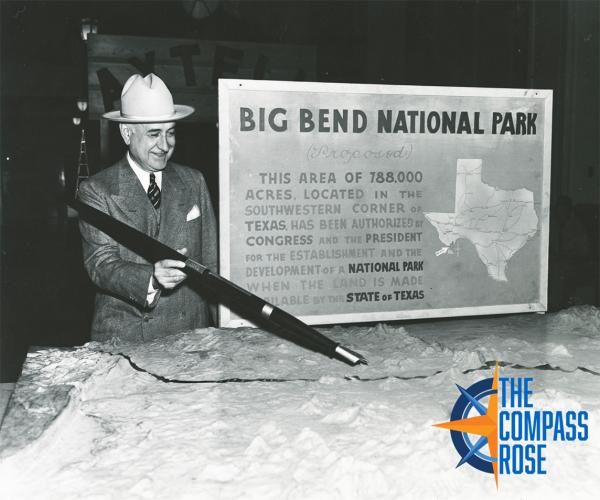
by Stephanie Luke


by Stephanie Luke
The purpose of The Compass Rose is to raise awareness of Special Collections' resources and to foster the use of these resources. The blog series also reports significant new programs, initiatives, and acquisitions of Special Collections.
Saturday, June 12th will mark the 77th anniversary of the establishment of Big Bend National Park. Big Bend, Texas’ first national park, would never have been realized without the concentrated efforts of a few determined Texans.
In the 1930s, J.O. Langford, E.E. Townsend, and Amon Carter began to envision what a park might look like in the Big Bend area, thus named because of the large bend in the Rio Grande on the southern border of Texas. The three men began to rally support for the purchase of land and established the Texas Canyons State Park in 1933. This year continued to mark significant milestones in the process of establishing the park as a federal site. A few months after its establishment, Texas Canyons State Park was renamed Big Bend State Park (National Parks Service 2020). Soon the Chisos Mountains were added to the park’s lands. That same year, the U.S. government ordered that employees of the National Park Service (NPS) explore the park and evaluate it for consideration as a federal site (Jameson 1995).
In January 1934, the team from NPS issued a report that supported the federal government’s acquisition of the state park. Following this report, the Civilian Conservation Corps (CCC), an agency created from Franklin Delano Roosevelt's New Deal, began building roads and trails in order to make the land accessible for visitors (National Parks Service 2020). A year later, on June 20, 1935, President Roosevelt signed a bill that delineated the specifics for transferring the park from Texas to the federal government. The site was “for the benefit and enjoyment of the people,” but additional land could be secured “only by public and private donations” (U.S. Congress 1935, §1).
In 1941, the state parks board, the Big Bend land department, and NPS officials met to discuss the purchase of additional land. They evaluated the price of the land based on access to water and its ability to support grazing. They agreed to pay $1.00 per acre for very poor land, $1.50 per acre for poor land, $2.00 per acre for fair land, and over $2.00 for the best land, which would assumedly be in the Chisos Mountains (Welch 2002, 312). Soon after, the land department began approaching landowners.
The state set a deadline of August 31, 1942 for the land department to acquire any additional land. Texas gave the department a $1.5 million appropriation to acquire over 700,00 acres. Before the deadline, however, the land office had exhausted the money from this appropriation and had yet to secure all the acreage they planned on purchasing. Amon Carter and the Texas Big Bend Association provided almost $8,400 of donated funds, while local chapters of the Association raised over $15,000. On September 5, 1943, Texas governor Coke Stevenson presented the deed for the land to the NPS. As per the bill passed by Congress, the federal government was given exclusive jurisdiction over the park’s land, the deed to which Stevenson signed on December 20, 1943 (Welch 2002, 312-313).
In 1944, the year after Big Bend became a national park, the NPS reported that 1,400 people visited the park. The annual number of visitors has steadily increased, hitting the ten thousands in 1946 and the hundred thousands in 1963. In 1976, Big Bend was declared an “International Biosphere Reserve” by the United Nations. The NPS reports that since 1944 Big Bend has had over 17,500,000 visitors. For 2020, Big Bend was the 37th most visited national park and the 110th most visited national site (National Parks Service, 2021). The park is over 801,000 acres (more than 1,200 square miles) and is the 15th largest U.S. national park. Big Bend National Park represents the vision and efforts of Texans and is an example of all the state has to offer.
Jameson, John. “Big Bend National Park,” Handbook of Texas Online. Last modified June 1, 1995. Accessed June 10, 2021. https://www.tshaonline.org/handbook/entries/big-bend-national-park.
Koch, Peter and National Parks Service (U.S. Department of the Interior). “Big Bend National Park.” Texas Archive of the Moving Images. 1940s. Video, 5:48. https://texasarchive.org/2006_00008.
National Parks Service (U.S. Department of the Interior). “Big Bend Fact Sheet.” National Park Services. Last updated February 25, 2019. Accessed June 9, 2021. https://www.nps.gov/bibe/learn/management/statistics.htm.
—. “Park Reports.” National Park Services. Last updated 2021. Accessed June 9, 2021. https://irma.nps.gov/STATS/Reports/Park/BIBE.
—. “Texas’ Gift to the Nation.” National Park Service. Last updated August 3, 2020. Accessed June 9, 2021. https://www.nps.gov/bibe/learn/historyculture/tgttn.htm.
U.S. Congress, Senate. An act to provide for the establishment of the Big Bend National Park in the state of Texas, and for other purposes, S 2131, 74th Cong., 1st sess., introduced in Senate June 20, 1935. Accessed June 6, 2001. https://govtrackus.s3.amazonaws.com/legislink/pdf/stat/49/STATUTE-49-Pg393b.pdf.
Welsh, Michael. Landscape of Ghosts, River of Dreams: A History of Big Bend National Park. Washington D.C.: National Parks Service (U.S. Department of the Interior), 2002. https://www.nps.gov/parkhistory/online_books/bibe/adhi/adhi.htm.
Add new comment